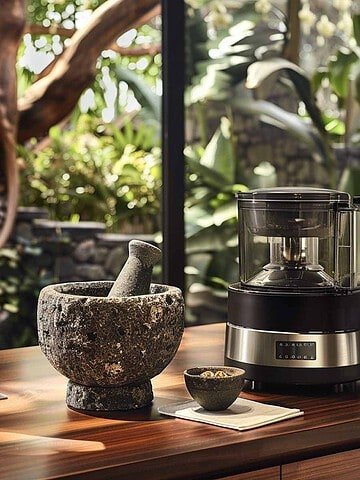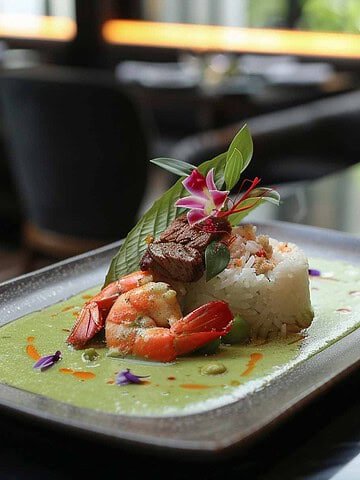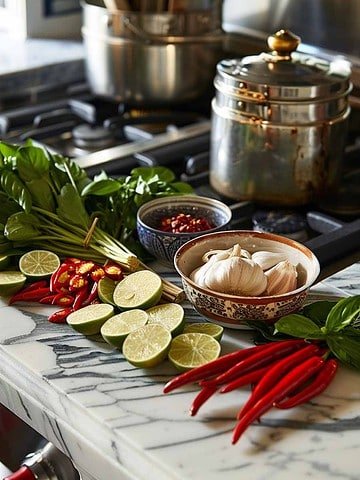Thailand is famous for its vibrant culture, beautiful landscapes, and friendly hospitality. Its diverse culinary heritage is equally renowned. Beyond the well-known dishes often found in Thai restaurants worldwide, there is a tapestry of flavors and ingredients that locals cherish daily. Let's delve deep into the heart of Thai cuisine, a diverse and intriguing world of flavors, and uncover what truly satisfies the appetites of the people who call this beautiful country home.
Rice: The Foundation of Thai Meals
Central to every Thai meal is rice, specifically jasmine rice, which serves as the cornerstone upon which a variety of dishes are enjoyed. Rice is not merely a side dish but the essential component that completes every dining experience. The phrase "kin khao," which translates to "eat rice," reflects the importance and respect for this staple in Thai culture and cuisine. Whether steamed or fried rice, locals consider a meal incomplete without this fundamental grain.
Street Food: A Culinary Adventure
One of the highlights of Thai cuisine is its dynamic street food culture. From bustling markets to humble roadside stalls, Thailand's street food vendors offer an array of dishes that cater to every palate. Here's a glimpse into some of the street food favorites enjoyed by locals across the country:
Som Tum (Papaya Salad)
The "Som Tum" salad is a spicy and refreshing dish made from shredded unripe papaya, cherry tomatoes, green beans, peanuts, garlic, chili peppers, fish sauce, lime juice, and palm sugar. It's crushed in a mortar and pestle to unleash the flavors and achieve a balanced mixture of spicy, tangy, and crunchy elements. Som Tum is a local favorite for its vibrant taste and ability to complement any meal.
Tom Yum Goong
Tom Yum Goong is a quintessential Thai soup known for its bold and refreshing flavors. It features a fragrant broth infused with lemongrass, kaffir lime leaves, galangal (Thai ginger), chili peppers, fish sauce, and lime juice. The soup is typically loaded with plump shrimp (goong) and mushrooms, creating a delightful interplay of spicy, sour, and savory tastes. Tom Yum Goong showcases the depth and complexity of Thai culinary craftsmanship.
Khao Pad (Fried Rice)
Khao Pad is a simple yet satisfying fried rice dish staple in Thai households. It's typically prepared with jasmine rice stir-fried with eggs, onions, garlic, and meats such as chicken, pork, or shrimp. Seasoned with soy sauce and garnished with cucumber slices and lime wedges, Khao Pad is a comforting and versatile dish that locals of all ages enjoy.
Gaeng Keow Wan Gai (Green Curry Chicken)
Green Curry Chicken is a deliciously creamy and aromatic dish you'll love! It really captures the beautiful balance of flavors in Thai cuisine. The paste is made from green chilies, Thai basil, lemongrass, garlic, shallots, and other aromatic herbs, simmered with coconut milk and tender chicken pieces. The result is a vibrant green-hued curry that's mildly spicy yet incredibly flavorful, making it a favorite choice for lunch and dinner.
Regional Specialties: Culinary Diversity Across Thailand
Thailand's culinary landscape is as diverse as its geographical regions. Each region boasts distinct flavors, ingredients, and cooking techniques, showcasing the country's cultural richness. Here are some regional specialties that highlight the culinary diversity of Thailand:
Northern Thailand
Northern Thai cuisine is characterized by its hearty and aromatic dishes that reflect the region's mountainous terrain and cooler climate. Staples include:
Khao Soi: A noodle soup with origins in Burmese cuisine, Khao Soi features egg noodles in a curry broth topped with crispy fried noodles, pickled mustard greens, shallots, lime, and your choice of meat (commonly chicken or beef).Sai Oua: Northern Thai sausage made with minced pork, herbs, and spices, and often flavored with aromatic ingredients like lemongrass and kaffir lime leaves. It's grilled or fried and served with sticky rice and fresh vegetables.
Isaan (Northeastern Thailand)
Isaan cuisine is renowned for its bold and spicy flavors, influenced by Laos and characterized by its use of sticky rice (khao niew) as a staple. Popular dishes include:
Laab: A spicy minced meat salad typically made with minced pork or chicken seasoned with fish sauce, lime juice, toasted rice powder, and fresh herbs like mint and cilantro. Laab is known for its intense flavors and is often enjoyed with sticky rice.
Som Tom Thai is a fiery and tangy variation of papaya salad that's more similar to its central Thai counterpart. It features shredded unripe papaya, tomatoes, green beans, peanuts, garlic, chili peppers, fish sauce, lime juice, and palm sugar.
Southern Thailand
Southern Thai cuisine is characterized by its spiciness, influenced by neighboring Malaysia, and features abundant fresh seafood. Key dishes include:
Gaeng Massaman: A rich and fragrant curry that blends Thai spices with influences from Indian and Malay cuisines. It typically includes tender chunks of beef or chicken simmered in coconut milk with potatoes, onions, peanuts, and spices like cinnamon and star anise.
Khanom Jeen: Fermented rice noodles served with various curries and fresh vegetables reflect the region's emphasis on seafood and aromatic herbs.
Desserts: Sweet Delights of Thailand
All exploration of Thai cuisine is complete with indulging in the country's delightful array of desserts. Thai desserts are characterized by their use of tropical fruits, coconut milk, and glutinous rice, creating sweet treats that perfectly conclude any meal. Here are some popular Thai desserts enjoyed by locals:
- Khao Niew Mamuang (Mango Sticky Rice): A beloved dessert featuring ripe mango slices served with sweetened Sticky rice is topped with coconut milk and sprinkled with toasted sesame seeds or mung beans.
- Khanom Krok: Coconut pancakes made from a batter of rice flour, coconut milk, and sugar, cooked in a unique grill with half-spherical molds to create bite-sized pancakes with a crispy edge and a soft, custard-like center.
- Tub Tim Grob: A refreshing dessert made with water chestnuts coated in vibrant red tapioca flour and served in sweetened coconut milk with crushed ice. It's a popular choice to cool down on hot Thai days.
Culinary Traditions and Eating Culture
Thai cuisine is not just about the dishes but also about the cultural traditions and social rituals surrounding eating. Meals are often communal affairs where multiple dishes are shared among family and friends. This communal dining style allows for diverse flavors and textures to be enjoyed together, enhancing the dining experience and fostering social bonds.
In Thai culture, food is deeply intertwined with everyday life, festivals, and religious ceremonies. Traditional Thai cooking techniques, such as pounding ingredients in a mortar and pestle (krok) or grilling over an open flame, highlight the importance of craftsmanship and attention to detail in creating authentic flavors.
The Influence of Buddhism on Thai Cuisine
Buddhism significantly influences Thai culinary traditions, particularly regarding dietary practices and mindfulness. Many Thai Buddhists adhere to vegetarian or vegan diets, especially during religious observances or holy days. Temples (wats) often serve simple yet flavorful vegetarian meals that adhere to Buddhist principles of non-violence and compassion towards all living beings.
Evolution and Adaptation of Thai Cuisine
While traditional dishes form the backbone of Thai cuisine, the culinary landscape of Thailand continues to evolve with modern influences and global trends. Urbanization, international travel, and exposure to diverse cuisines have adapted Thai dishes to suit contemporary tastes and preferences. As a result, you'll find innovative fusion restaurants, gourmet street food vendors, and trendy cafes that offer unique interpretations of classic Thai flavors.
Sustainable Practices and Ethical Eating
In recent years, there has been a growing awareness of sustainable practices and ethical eating within Thailand's culinary scene. Locally sourced ingredients and organic farming practices are increasingly important for reducing food waste and are key considerations for chefs and restaurateurs. Farm-to-table initiatives and community-supported agriculture (CSA) programs are gaining traction, allowing consumers to support local farmers and enjoy fresh, seasonal produce.
Culinary Tourism: Exploring Thailand Through Food
Culinary tourism has become a popular way for travelers to explore Thailand's diverse regions and immerse themselves in its culinary traditions. Opportunities to sample authentic dishes, Discover traditional cooking methods, and deepen your understanding of the cultural importance of food in Thai society. Are offered through food tours, cooking classes, and visits to local markets.
Conclusion: The Enduring Allure of Thai Cuisine
Thai cuisine captivates the senses with its vibrant colors, bold flavors, and aromatic spices. Beyond the popular dishes served in restaurants worldwide, exploring what locals eat reveals a deep appreciation for fresh ingredients, culinary craftsmanship, and the joy of sharing meals with loved ones. Whether enjoying a bowl of spicy Tom Yum soup at a street-side stall





Leave a Reply